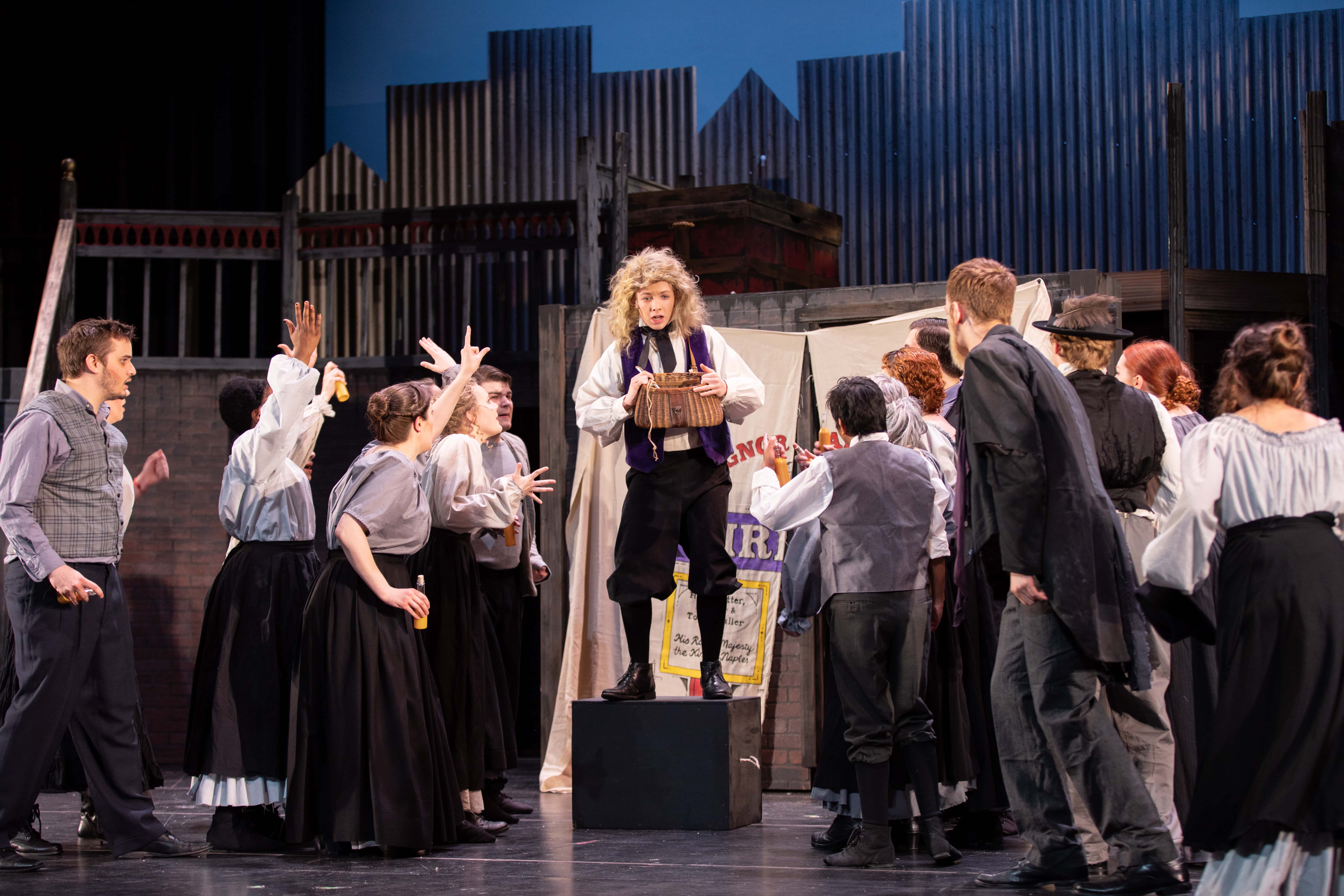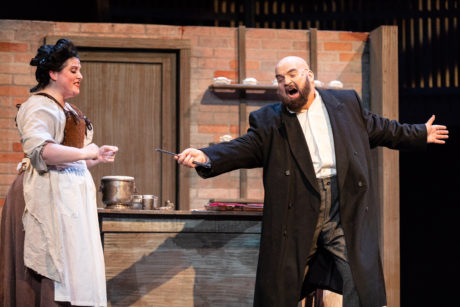Stephen Sondheim himself felt some uncertainty in categorizing Sweeney Todd, the 1979 show that many regard as the masterpiece of his long and spectacular career. In his annotated book of lyrics, Finishing the Hat, he settled on “dark operetta” and refers to it as “a movie for the stage.” There is an alternative way of thinking about Sweeney; as a secular fable of damnation. A good man, cruelly wronged, thwarted in seeking revenge, enlists on the side of darkness and death, bringing despair to himself and doom on almost everyone around him. The “City on Fire” referenced in a powerful Act 2 ensemble number–Dickensian London in the early industrial age–becomes a physical metaphor for the hell in which Sweeney lives, moves, and kills.

The backstory is straightforward. Fifteen years before the action begins, the corrupt Judge Turpin sentenced a barber, Benjamin Barker, to transportation to Australia on an invented charge, so that Turpin could have his way with Barker’s pretty young wife. After escaping, Barker returns to London as Sweeney Todd to seek his wife and young daughter and to take revenge on Turpin. As Todd sings in the opening number, “What happened then — well that’s the play, and he wouldn’t want us to give it away.”
He needn’t fret. With Sweeney, as with any classic that has frequently been performed over many years – from Hamlet to La Traviata — plot surprises are long in the past. If memory serves, this is the third time that The Arlington Players (TAP) has mounted the show. Plot twists matter less than how well a production masters Sondheim’s famously challenging music. TAP’s production succeeds in meeting this test.

Three of the performances are outstanding. Brian Lyons-Burke brings a strong, rich bass-baritone voice and significant dramatic weight to the role of the evil Judge Turpin. His “Johanna,” a tour-de-force of guilt-ridden lust, is perhaps the best rendition of the song I have ever seen. Credit is due director Clare Shaffer for not bowdlerizing or even cutting the number, as has happened in more than one production I have encountered.
As Johanna, AnnaBelle Lowe nails her high soprano number “Green Finch and Linnet Bird,” while making her character less annoyingly ditzy than is often the case. Alden Michels brings a fine high lyric tenor sound to “Ladies in Their Sensitivities” while making the Beadle appropriately unctuous.
Sweeney is a great ensemble show, and the performance of TAP’s large ensemble is a major virtue of the production. Vocally precise in the various iterations of “The Ballad of Sweeney Todd,” the ensemble does itself particularly proud in the notoriously difficult “God, That’s Good” that opens Act 2. Shaffer makes effective use of the ensemble to represent the city crowds walking to and fro on the main stage level while the principals’ action is taking place on the high upstage platform, notably during “Epiphany” and the “Johanna Act II Sequence.” The ensemble’s seamless transition between a “Ballad of Sweeney Todd” interlude and portraying the inmates in “Fogg’s Asylum” is a high point. For reasons less clear, Shaffer has the ensemble carrying candles in the show’s opening number and the too-static Act 2 finale, creating a curious effect resembling a processing church choir.
Of the other supporting characters, Jack Kearney makes a touching Toby, shyly sweet in “Nothing’s Going to Harm You.” Kudos to Shaffer for casting a teenager in the role; productions using a young adult never seem to work as well. Brendan Hickey is as ardent a young lover as one could ask for as Anthony, though he is somewhat overshadowed vocally by Lowe in their duet “Kiss Me.” Jonathan Ohmart has a nice turn as the fraudulent barber Pirelli, like the Beadle a high tenor role. The colors of his costume stand out from designer Joan Lawrence’s mostly subdued palate. As the Beggar Woman, Judy Lewis often sounds screechy, defensible dramatically but missing the near-operatic vocal potential of her lines.
Which brings us to the leads. Erin Branigan’s Mrs. Lovett is youthful, energetic, and perky, performing her numbers – especially “By the Sea,” expressing her fantasy of domestic bliss – with verve and vocal facility. This approach to the character has the defects of its virtues, however. Mrs. Lovett, a woman of “limited wind,” works best if the character has a few more miles on her, both to give her the world-weary pragmatism of years in a dead-end London neighborhood and to appear maternal to Toby.

Bob McGrath’s often quiet, brooding, even introspective, take on Sweeney is an interesting departure. He emphasizes the character’s ceaseless grief and despair, more so than the towering outward rage that dominates many interpretations. This produces fascinating emotional complexity in “Epiphany,” the pivotal moment in the character’s arc. Not the strongest Sweeney vocally – his lower register tends to be gravelly at times – he is more than adequate to the role’s musical demands and teams well with Branigan in “A Little Priest,” the ghoulishly comic list song that ends Act 1.
Audrey Bodek’s set design features a very high platform spanning the back of the set, with stairways up both sides. Given the need for height to allow the bodies to go down the chute in Act 2, as well as to provide room for the roll-out unit used for Mrs. Lovett’s pie shop and parlor, this is understandable, though it does place many important scenes up high and far upstage, about as distant from the audience as possible. Shaffer makes good use of the multiple levels well throughout.
E-hui Woo’s lighting design is complicated and active, starting with specials for each ensemble member’s solo lines in the opening number. There are many shadings of light and darkness, as well as colored illumination of a white backdrop, though the colors seem rather random at times. Things get a touch too busy in the second act finale. Drew Moberly’s sound design gets the shrill factory whistles right and manages the frequently changing mic cues almost flawlessly. The roaring fire sound for the baking oven at the end of the show becomes overbearing, though. The reservoir razor handles typically used to squirt stage blood during the throat-cutting scenes can be balky; still, a more consistent and larger effusion of blood would have added to the shock value of the murders. Music Director Paige Rammelkamp’s orchestra had a few initial glitches and brief moments of dissensus with singers, but overall Rammelkamp handles the intense score with aplomb.
Running Time: Three hours and 10 minutes, including a 15-minute intermission.
Sweeney Todd, The Demon Barber of Fleet Street plays through April 28, 2018, at the Thomas Jefferson Theatre, 125 South Old Glebe Road, Arlington VA. For tickets, call 703-549-1063 or go online. For parking instructions at the theater during the current school construction, please visit The Arlington Players’ website.




